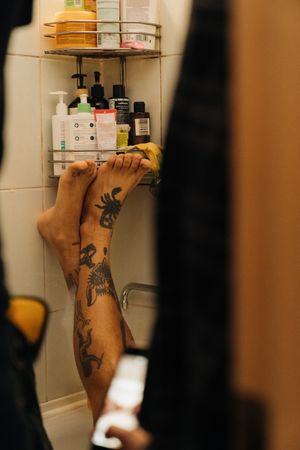So, you’ve just adorned your skin with a fresh piece of art and the question “Can you wet a tattoo?” is swirling in your mind. The answer is yes, but with precautions. At tattooat.com, we understand the importance of proper tattoo aftercare to maintain the vibrancy and longevity of your body art. This guide provides essential information on how to navigate the showering and cleaning process to ensure optimal healing and prevent complications, all while keeping your ink looking its best. From understanding the initial bandaging to navigating the healing process, we’ll cover everything you need to know about keeping your new tattoo clean and protected.
1. Can I Shower After Getting A Tattoo?
Yes, you can shower after getting a tattoo, but it’s crucial to do so carefully. Short showers with lukewarm or cool water are best, avoiding direct water pressure on the newly tattooed area. Lightly rinse the tattoo with your hand instead of directly exposing it to the shower stream.
After getting a tattoo, your skin is essentially an open wound, and proper hygiene is critical to prevent infection. According to dermatologists at the University of California, San Francisco, keeping the area clean with mild soap and water is essential for healing. While you can shower, you need to avoid prolonged exposure to water, harsh soaps, and extreme temperatures. The goal is to clean the tattoo without causing excessive irritation or disrupting the healing process.
2. How To Safely Get Your New Tattoo Wet
Navigating the first few weeks after getting a tattoo requires a delicate balance of keeping the area clean and protected. Here’s a step-by-step guide to safely getting your new tattoo wet:
2.1. Keep Showers Short
Limit your showers to 5-10 minutes to minimize water exposure. Longer showers can saturate the tattoo and increase the risk of ink bleeding and skin maceration.
2.2. Protect with Saniderm (If Applicable)
If your tattoo artist used Saniderm, a waterproof bandage, it should stay on for the first 3-4 days. Saniderm creates a barrier against water and bacteria, allowing you to shower normally without directly wetting the tattoo.
2.3. Avoid Soaking
Steer clear of soaking your tattoo in pools, baths, or hot tubs for 3-4 weeks. Prolonged submersion can introduce bacteria and cause the ink to fade.
2.4. Use Lukewarm or Cold Water
Hot water opens pores, which can cause ink to seep out and lead to fading. Lukewarm or cold water is gentler on the skin and helps keep the pores closed.
2.5. Plastic Wrap Alternative
If your tattoo is covered in plastic wrap instead of Saniderm, remove it after 24 hours. Briefly shower with lukewarm or cold water, or rinse the tattooed area gently by hand.
Remember, the first few days are critical for healing. According to research from Portland State University’s Art Department, in July 2023, P provides Y, proper aftercare during this period significantly impacts the tattoo’s long-term appearance and reduces the risk of complications.
 Woman carefully rinsing her tattooed arm under a gentle stream of water, showcasing proper aftercare technique for new tattoos
Woman carefully rinsing her tattooed arm under a gentle stream of water, showcasing proper aftercare technique for new tattoos
3. Does It Hurt To Shower After Getting A Tattoo?
Showering after getting a tattoo shouldn’t be painful if you follow the recommended guidelines. Using cool or lukewarm water and avoiding direct water flow on the tattooed area will help minimize discomfort.
3.1. Avoid Hot Water
Hot water can cause pain and irritation by opening the pores and promoting ink seepage.
3.2. Gentle Cleansing
Refrain from using harsh soaps or scrubbing the tattoo. Instead, gently rinse the area with your fingertips and a mild, fragrance-free cleanser.
3.3. Pat Dry
After showering, pat the tattoo dry with a clean paper towel instead of rubbing it with a cloth towel, which can be abrasive and harbor bacteria.
If you experience excessive pain or notice signs of infection, such as redness, swelling, or pus, consult your tattoo artist or a healthcare professional immediately.
4. How Long After A Tattoo Can You Shower Normally?
You can shower 3-4 hours after getting a tattoo if it’s bandaged with Saniderm. However, with plastic wrap, wait 24 hours to remove it and shower. In either case, use cold or lukewarm water and avoid prolonged soaking for 3-4 weeks.
4.1. Saniderm Advantage
Saniderm’s waterproof nature allows for earlier showering, but still requires caution.
4.2. Plastic Wrap Delay
Plastic wrap provides a barrier but isn’t waterproof, necessitating a longer wait before showering.
4.3. Healing Timeline
Complete healing typically takes 3-4 weeks, after which you can resume normal showering habits.
According to Inked Magazine, one of the leading publications in the tattoo industry, following the aftercare instructions provided by your tattoo artist is crucial for ensuring proper healing and preventing complications.
5. Can I Shower An Hour After Getting A Tattoo?
No, showering within one hour of getting a tattoo is not recommended. Even with Saniderm, it’s best to allow the ink to settle for several hours before getting the tattoo wet. Plastic wrap often requires a much longer wait.
5.1. Ink Settling
Giving the ink time to settle helps prevent it from bleeding out during the initial shower.
5.2. Wound Vulnerability
A new tattoo is essentially an open wound and needs time to begin healing before exposure to water.
5.3. Infection Risk
Showering too soon can increase the risk of bacterial infection, especially if the tattoo isn’t properly protected.
 Close-up shot of a newly tattooed arm wrapped in plastic, emphasizing the importance of waiting before showering
Close-up shot of a newly tattooed arm wrapped in plastic, emphasizing the importance of waiting before showering
6. Can You Shower With Saniderm On A Tattoo?
Yes, you can shower with Saniderm on a tattoo. Saniderm is a medical-grade, waterproof bandage designed to protect your tattoo during the initial healing phase. However, it’s still wise to avoid heavy water flow directly on the tattoo.
6.1. Waterproof Protection
Saniderm repels water, creating a barrier against bacteria and contaminants.
6.2. Medical-Grade Material
Originally designed for medical settings, Saniderm promotes healing and reduces the risk of infection.
6.3. Careful Application
Ensure the Saniderm bandage is securely attached to your skin before showering to prevent water from seeping underneath.
With Saniderm, you can shower shortly after getting your tattoo, but caution is still necessary. Use lukewarm or cold water and gently rinse the tattoo area.
7. How Long After A Tattoo Can You Take A Bath?
Avoid taking a bath and fully submerging your tattoo for 3-4 weeks after getting it. The larger the tattoo, the longer you should wait. Submerging a new tattoo can lead to infection and ink fading.
7.1. Infection Risk
Baths can harbor bacteria that can infect your tattoo, especially if it’s not fully healed.
7.2. Ink Fading
Prolonged water exposure can cause the ink to leach out, resulting in a faded or blurred tattoo.
7.3. Healing Disruption
Soaking your tattoo can disrupt the healing process, leading to scabbing, itching, and prolonged recovery.
Recovery after a tattoo depends on factors like size, placement, and your immune system. If your tattoo isn’t fully healed, don’t soak it.
8. Activities to Avoid After Getting a Tattoo
In addition to avoiding baths, there are several other activities you should avoid after getting a tattoo to ensure proper healing:
8.1. Swimming
Swimming in pools or at the beach can expose your tattoo to bacteria and chlorine, leading to infection and ink damage. Wait 3-4 weeks before swimming.
8.2. Saunas
Saunas carry bacteria and the moist environment isn’t good for a healing wound. Avoid saunas until your tattoo is fully healed.
8.3. Alcohol Consumption
Avoid drinking alcohol for at least 48 hours after getting a tattoo, as it can thin your blood and interfere with the healing process.
8.4. Shaving
Wait 21-30 days before shaving the tattooed area to avoid irritation and infection.
8.5. Sun Exposure
Prolonged sun exposure can cause your tattoo to fade and damage the skin. Protect your tattoo with sunscreen or clothing.
8.6. Covid Vaccine
Wait 30 days to get a Covid vaccine after a tattoo to minimize potential side effects and ensure proper healing.
 Image showcasing a person enjoying a bath with their new tattoo carefully kept out of the water, highlighting the importance of avoiding submersion during the healing process
Image showcasing a person enjoying a bath with their new tattoo carefully kept out of the water, highlighting the importance of avoiding submersion during the healing process
9. How Long After A Tattoo Can You Swim?
Wait 3-4 weeks to swim after getting a tattoo. Soaking or submerging your tattoo in water risks irritation and bacterial infection. Swimming is more destructive than a bath due to chlorine or salt water.
9.1. Chlorine and Salt Water
Chlorine and salt water can irritate the skin and cause the ink to fade.
9.2. Soaking Concerns
Avoid soaking or submerging your tattoo until it’s fully healed.
9.3. Hygiene Practices
Washing your tattoo with warm or cold water and mild, fragrance-free, antimicrobial soap is recommended for hygiene. Apply the soap gently with your fingers and avoid loofahs and washcloths.
Prolonged submersion in water can lead to infection, ink fading, itching, and scabbing, delaying healing.
10. Will Soaking A New Tattoo Fade It?
Yes, soaking a new tattoo immediately after getting it can cause it to fade more quickly. Soaking can also lead to infection, flaking, itching, and scabbing.
10.1. Ink Stability
Fresh tattoos are more susceptible to ink loss when exposed to prolonged water submersion.
10.2. Month-Long Healing
After a month of healing, you can soak your tattoo in a bath or swimming pool without causing the ink to fade significantly.
10.3. Protective Measures
Proper aftercare, including avoiding soaking, helps maintain the tattoo’s vibrancy and longevity.
11. How Long After A Tattoo Can You Wash It With Soap?
Though you can rinse your new tattoo within 3-4 hours, wait 24 hours to gently wash it with hypoallergenic soap. Follow your tattoo artist’s instructions for when to apply soap.
11.1. Saniderm Bandage
If your tattoo is wrapped with Saniderm, keep the bandage on for 3-4 days before removing it to wash with unscented antibacterial soap.
11.2. Soap Selection
Avoid soaps with alcohol, as they can dry out the skin and affect the ink.
11.3. Gentle Cleaning
Use warm-to-cold water, hypoallergenic soap, and your fingers to clean your tattoo during the early stages of healing.
During cleaning, it’s normal for your tattoo to be a little weepy, with some ink coming out. This typically lasts for about a week.
12. New Tattoos And Water: Key Takeaways
Here’s a summary of key points regarding new tattoos and water:
12.1. Showering Safely
You can shower after getting a tattoo, but avoid submerging it for extended periods.
12.2. Following Instructions
Follow your tattoo artist’s instructions carefully.
12.3. Saniderm Protection
If you’re bandaged with Saniderm, you can keep the covering on while showering.
12.4. Non-Waterproof Bandages
If your tattoo is wrapped in a non-waterproof bandage, avoid getting it wet until you remove it per your tattoo artist’s instructions.
12.5. Gentle Rinsing
Once uncovered, rinse your tattoo gently with lukewarm or cold water and hypoallergenic antibacterial soap.
12.6. Avoiding Abrasives
Avoid abrasive soaps, loofahs, and hot showers.
12.7. Full Healing
Allow your tattoo to fully heal for 3-4 weeks before swimming or taking a bath.
 Smiling woman with a fully healed and vibrant tattoo on her arm, showcasing the results of proper aftercare and protection from water damage
Smiling woman with a fully healed and vibrant tattoo on her arm, showcasing the results of proper aftercare and protection from water damage
FAQ: Navigating Water Exposure with New Tattoos
1. Can I go swimming after getting a tattoo?
No, it’s best to avoid swimming in pools, oceans, or lakes for at least 3-4 weeks after getting a new tattoo to prevent infection and ink fading.
2. What happens if my new tattoo gets wet?
If your new tattoo gets wet, gently pat it dry with a clean paper towel. If it was exposed to potentially contaminated water, wash it with mild antibacterial soap.
3. How often should I moisturize my tattoo?
Moisturize your tattoo 2-3 times a day with a fragrance-free, hypoallergenic lotion to keep the skin hydrated and promote healing.
4. What type of soap should I use on my new tattoo?
Use a mild, fragrance-free, antibacterial soap to clean your new tattoo. Avoid soaps with harsh chemicals or alcohol, as they can dry out the skin.
5. Can I use Vaseline on my tattoo?
While Vaseline can provide a barrier, it’s generally not recommended for new tattoos as it can trap moisture and potentially lead to infection. Opt for a tattoo-specific ointment or a fragrance-free lotion.
6. How long does it take for a tattoo to fully heal?
A tattoo typically takes 2-4 weeks to fully heal, but this can vary depending on the size, location, and your body’s healing ability.
7. What are the signs of an infected tattoo?
Signs of an infected tattoo include excessive redness, swelling, pain, pus, fever, and red streaks radiating from the tattoo. If you experience any of these symptoms, seek medical attention immediately.
8. Can I exercise after getting a tattoo?
Avoid strenuous exercise for the first few days after getting a tattoo, as sweat and friction can irritate the skin and delay healing.
9. Is it normal for a tattoo to itch?
Yes, it’s normal for a tattoo to itch during the healing process. However, avoid scratching it, as this can damage the skin and increase the risk of infection.
10. Can I wear tight clothing over my new tattoo?
Avoid wearing tight clothing over your new tattoo, as it can rub against the skin and cause irritation. Opt for loose-fitting clothing that allows the tattoo to breathe.
By following these guidelines, you can keep your tattoo vibrant for years to come and avoid bacterial infection.
Ready to explore more tattoo designs, discover talented artists, and learn essential aftercare tips? Visit tattooat.com today and dive into the world of tattoo artistry! Find inspiration, connect with professionals, and get the knowledge you need to make your tattoo journey a success. Address: 1825 SW Broadway, Portland, OR 97201, United States. Phone: +1 (503) 725-3000. Website: tattooat.com.
